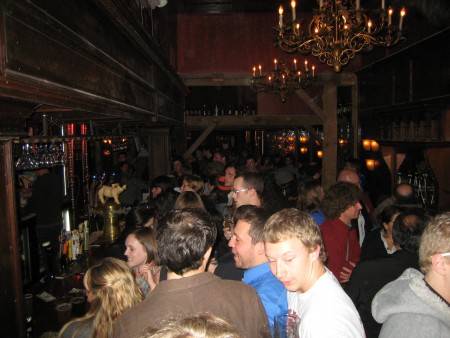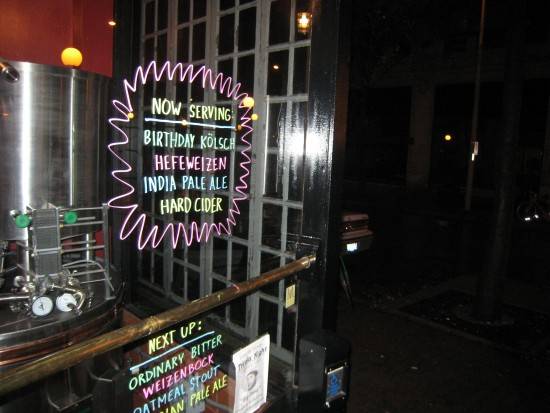When Benjamin Franklin said, “Beer is living proof that God loves us and wants us to be happy,” it is doubtful whether he knew what a cliche his statement would become. And yet, last night, literally hundreds of Champaign-Urbanians came to The Blind Pig Brewery (known also as The Piglet) to partake of that cliche — to guzzle down a pint or two of life-affirming, locally-brewed booze.

Yes, ladies and gentlemen, the wait is over. After months of anticipation, it was announced that the water, malt, hops and yeast that were tossed into the giant stainless steel brewers you’ve seen looming over Neil Street is finally beer. Mere months after brewmaster Bill Morgan pitched the yeast into four towering vats of wort, The Piglet gave Champaign-Urbana its first commercially brewed beer since Joe’s Brewery actually brewed — and it was pretty good.

Now here our arbitrary opinions:
Kölsch
 Not completely a lager, not completely an ale, Kölsch is fermented with ale yeast and then it is lagered so as to mellow out some of its ale-like qualities. The final product of this traditional brewing process generally tends to be a smooth but complex beer that can be enjoyed for its lighthearted texture and its complex flavor. Brewmaster Bill put together a subtle, almost perfume-like brew here, anchored by a hop flavor with just enough crispness to balance out its pretentious looking umlaut. —Caleb Curtiss
Not completely a lager, not completely an ale, Kölsch is fermented with ale yeast and then it is lagered so as to mellow out some of its ale-like qualities. The final product of this traditional brewing process generally tends to be a smooth but complex beer that can be enjoyed for its lighthearted texture and its complex flavor. Brewmaster Bill put together a subtle, almost perfume-like brew here, anchored by a hop flavor with just enough crispness to balance out its pretentious looking umlaut. —Caleb Curtiss
——
I guess this one reminded me of Rolling Rock. It was a tasty light beer with a bitter undertone that wasn’t overwhelming. Plus, it came in a normal pint glass, which helped me avoid self-consciousness whilst enjoying it. Maybe it’s a PBR and I’m a garden-variety hipster — you’ll never know! —Joel Gillespie
Hefe Weizen
 Hefe weizen is my favorite kind of beer, and this was a good representative. It wasn’t very fruity and had a clean finish, which allowed me to feel manly even though I was drinking a nearly-transparent beer from a tall, narrow glass. Hold the orange slice. Bottoms up, fellow workers of the world! — Joel Gillespie
Hefe weizen is my favorite kind of beer, and this was a good representative. It wasn’t very fruity and had a clean finish, which allowed me to feel manly even though I was drinking a nearly-transparent beer from a tall, narrow glass. Hold the orange slice. Bottoms up, fellow workers of the world! — Joel Gillespie
——
Before brewing a five-gallon batch of my own, I used to think that hefe weizen was somehow infused with banana and clove flavors. It isn’t, but those flavors are most certainly generated through the mild hop flavor, the wheat malt, and most importanly, the German ale yeast. The Pig’s version of hefe weizen is solid. It essentially tastes like most of the mass marketed hefes out there today, which is a compliment given that most of those places have been making beer since before we had a constitution. —Caleb Curtiss
India Pale Ale
 IPAs may well be my favorite kind of beer. When done well, they’re hoppy and crisp, with enough malt to balance out the bitterness that defines it. Now I have to say that I’ve sampled a pretty wide variety of IPAs in my day and lately have been disappointed at how many of them try to melt my face off with bitterness without paying me the common courtesy of a well balanced, approachable flavor profile. The Piglet’s IPA does not suffer from this folly. Weighing in at 55 IBUs, it has enough hop flavor to keep you interested and enough malt flavor to keep you from switching over to PBR. A well crafted effort that’s more than worth a sip — but be sure to get there quick — as of 9 p.m. last night, they only had a half a keg left! —Caleb Curtiss
IPAs may well be my favorite kind of beer. When done well, they’re hoppy and crisp, with enough malt to balance out the bitterness that defines it. Now I have to say that I’ve sampled a pretty wide variety of IPAs in my day and lately have been disappointed at how many of them try to melt my face off with bitterness without paying me the common courtesy of a well balanced, approachable flavor profile. The Piglet’s IPA does not suffer from this folly. Weighing in at 55 IBUs, it has enough hop flavor to keep you interested and enough malt flavor to keep you from switching over to PBR. A well crafted effort that’s more than worth a sip — but be sure to get there quick — as of 9 p.m. last night, they only had a half a keg left! —Caleb Curtiss
——
Because I can’t smell things too good (the result of a childhood broken nose) I tend to disregard the scent of things and fixate on how they play over my tongue. Because of this, I usually think of my beers as little tiny meals, and so usually I don’t appreciate the bitter taste associated with most popular IPA’s. I recall, as a child, being given little pieces of pa per with different flavors on them (this was apparently instructional to some degree). I do not remember putting the bitter piece of paper on my tongue and thinking ‘Yes! That is how I’ll spend my adulthood!’. But I also remember thinking Doritos’s and Mountain Dew kicked ass (whereas today, I am may still believe this to be true, but feel a quiet shame for it). As it turns out, the IPA’s I’ve been un-enjoying over the past few years are actually ‘double IPA’s’, which have a pretty hefty International Bitterness Unit (IBU) rating. However… the Blind Pig Brewery IPA is a ‘single’ IPA, which makes it awesome and delicious to those who don’t drink just to show how much of something terrible they can put up with. Three sips in and you’ll taste bits of citrus-y fruit pass over your tongue. Three beers in, and you’ll be hugging your bartender. Good stuff. —Michael Curtin
per with different flavors on them (this was apparently instructional to some degree). I do not remember putting the bitter piece of paper on my tongue and thinking ‘Yes! That is how I’ll spend my adulthood!’. But I also remember thinking Doritos’s and Mountain Dew kicked ass (whereas today, I am may still believe this to be true, but feel a quiet shame for it). As it turns out, the IPA’s I’ve been un-enjoying over the past few years are actually ‘double IPA’s’, which have a pretty hefty International Bitterness Unit (IBU) rating. However… the Blind Pig Brewery IPA is a ‘single’ IPA, which makes it awesome and delicious to those who don’t drink just to show how much of something terrible they can put up with. Three sips in and you’ll taste bits of citrus-y fruit pass over your tongue. Three beers in, and you’ll be hugging your bartender. Good stuff. —Michael Curtin
Hard Cider (Made with Curtis Orchard apples)
 For some reason not related to taste, texture, or intelligence, I hate apples. Furthermore, I hate the very concept of turning apple cider into booze. To me, it’s a ridiculous notion, like fermenting Kool-Aid, or cutting pixie-sticks with cocaine. But before you get caught up with the ins and outs of subverting my childhood with adult depression-induced debauchery, consider this: I really like the Blind Pig Brewery’s Hard Cider. Here’s why; it tastes like early summer apples when you bite too close to the core, as opposed to fall-time apple-mush, which always invokes a ‘slipping into the darkness of winter’ feeling. It’s a summer cider, bitter and boozy, and it makes your tongue feel like it’s been zapped with a battery. I approve in a sort of stoic, clear eyed Illinois way. —Michael Curtin
For some reason not related to taste, texture, or intelligence, I hate apples. Furthermore, I hate the very concept of turning apple cider into booze. To me, it’s a ridiculous notion, like fermenting Kool-Aid, or cutting pixie-sticks with cocaine. But before you get caught up with the ins and outs of subverting my childhood with adult depression-induced debauchery, consider this: I really like the Blind Pig Brewery’s Hard Cider. Here’s why; it tastes like early summer apples when you bite too close to the core, as opposed to fall-time apple-mush, which always invokes a ‘slipping into the darkness of winter’ feeling. It’s a summer cider, bitter and boozy, and it makes your tongue feel like it’s been zapped with a battery. I approve in a sort of stoic, clear eyed Illinois way. —Michael Curtin
——
The last time I had a hard cider I was hitchhiking around the British Isles with a close friend. Not being of legal age back home, a great portion of our time was spent thumbing rides from one pub to the next. I’ve now had a full decade to let that experience ruminate and wrap itself in the hazy golden light of nolstagia. That being said, this cider was as good as anything I remember drinking on that trip. Maybe it’s the local apples (I love you, Curtis), or maybe it’s the local water, what with the Mahomet aquifer holding 4 trillion gallons of the freshest 12,000-year-old water you’ll ever taste. Either way, the end product is pretty damn good. The fruit taste is subtle even as it provides a distinct and suprising element to the tongue of one’s drunk. Clear and crisp, the cider thankfully lacked the cloying frutiness and perfume aftertaste that is its potential. I also tried the Kolsch, but this was, easily, my preferred drink for the night. —Robert Hirschfeld








